The Perfect Backcountry Ski Setup for Upland Hunting
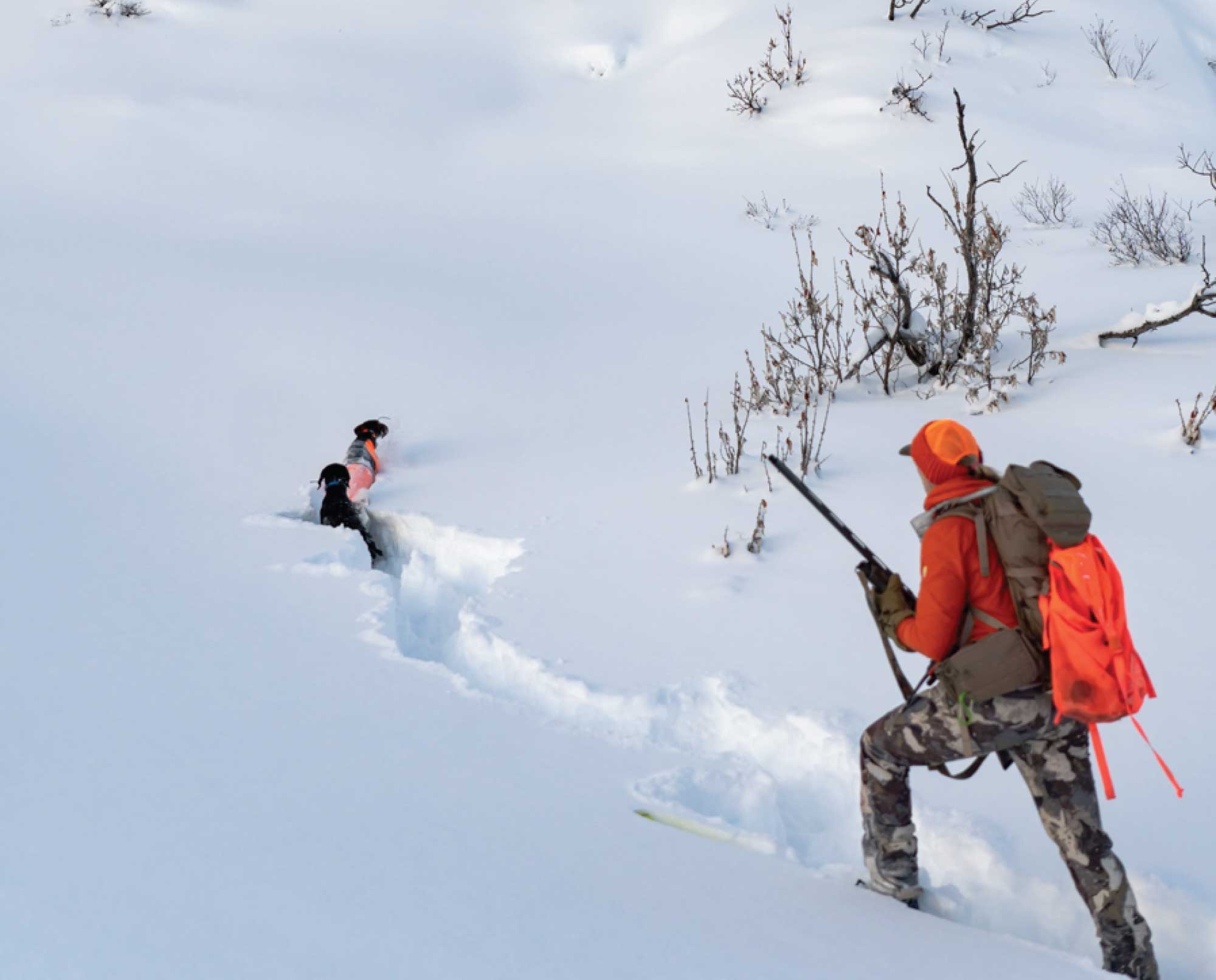
Chase upland birds all season long while efficiently gliding over wild snow with the perfect ski setup
Three years ago, I met a bird-crazy vanlifer named Scott Johnson. At the time, I was dipping my toe into the world of bird hunting, naively wandering through the woods, and plinking spruce grouse with a .22 rifle. Scott talked me into buying a shotgun. He showed me the beauty of hunting behind a well-trained bird dog. Conversely, I talked Scott into ditching his snowshoes and showed him the beauty of swiftly sliding over snow on backcountry skis. After that, both of our lives changed for the better.
When snowshoeing, you have to pick your feet up. High-stepping through snow is really tiring. Snow builds up on top of each snowshoe; that additional weight must be lifted up with every step. Skiing is similar to moving a very heavy object on a slippery floor. Don’t pick it up; slide it. In this way, a skier can cover more ground with less effort. Additionally, when skiing, you always have both feet on the ground which is great for hunters with limited balance or mobility.
Scott wrote about his introduction to hunting on skis after our first season learning from each other in 2019. Since then, he and I have tried many iterations of ski setups and we’ve learned a lot of lessons regarding building great ski kits for hunting on wild snow.
I have been backcountry skiing for 25 years and am familiar with every type of ski gear. The recipe presented in this article for a hunting ski setup is what I believe best serves backcountry hunters. Personally, I will never go back to snowshoes and now that he’s tried my prescribed ski setup, neither will Scott. I have helped several snowshoe hunters in my local NAVHDA chapter try skis for the first time, too, and they’ve all converted to the ease of skiing.
If you’ve tried upland hunting on skis and had a bad time, I’m here to show you a better way. Or, if you’re an experienced snowshoe hunter and think there’s no way that skis can outperform snowshoes in gnarly terrain, maybe I can help make your winter hunting days go further and faster. Hopefully, your dog can keep up with you!
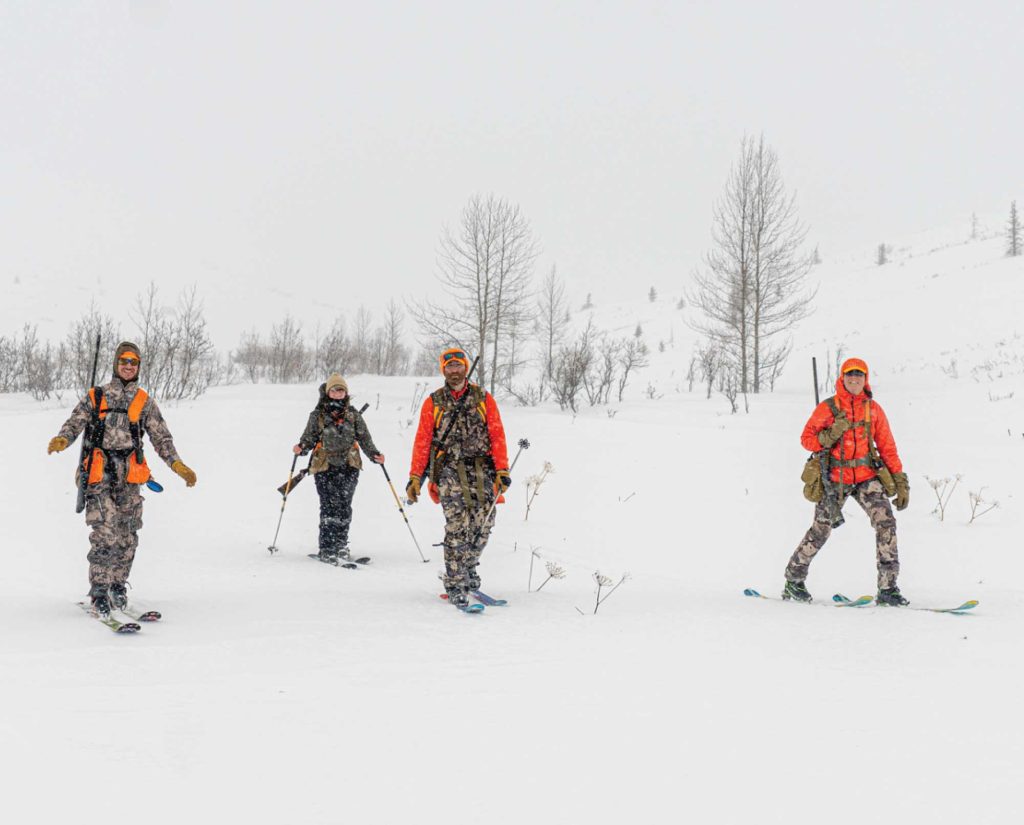
Bad Backcountry Ski Setups for Hunters
Let’s go through some of the backcountry skis types commercially available and why they’re not ideal for hunting. First up are some skis that are actually marketed as hunting skis.
At first glance, the Altai Hok, the Kar 147 by Skinbased OAC, and the Black Diamond Glidelite seem great for hunting. Their short length makes them very maneuverable in tight brush. The integrated partial climbing skin is not intimidating to newbie backcountry users. Good marketing promises the partial skin to be both fast on the flats, yet grippy enough for uphills. The $400 to $500 price range is very tempting as well.

Scott spent his first season and a half on a pair of the Black Diamond Glidelites. I bought some, too, and tried them several times. I do not recommend any of these “skin ski” designs. The integrated, partial-length climbing skin is not grippy enough to get through the steep terrain that upland hunters regularly encounter. The lack of a steel edge, or in some cases, a partial steel edge is not enough to side hill on firmer snow or ice. Regarding floatation in soft snow, the length is too short to make up for the decreased width compared to a snowshoe. Lastly, the lightweight construction is too unstable to go over rugged terrain or to shoot from.
Scott and I still have our Glidelite skis. We loan them out to friends who want to try ski hunting for the first time before they commit to buying their own gear. They’re better than nothing, but it’s still a relatively weak setup.
If you walk into an REI, describe upland hunting to the salesperson, and ask for a ski setup, XCD cross country downhill skis are probably what they will sell you. Models include the Voile Objective BC, Fisher S-Bounds, Madshus Panorama and Annum, the Rossignol BC 120, Karhu Guide and 10th Mountain. They come in longer lengths, have stiffer construction, and full-length metal edges. Some have an integrated partial climbing skin like the trekking skis above, but many have a fishscale base, otherwise known as “waxless.”
While the skis themselves are fine, the fishscale base performs worse than the partial climbing skins on the skin-skis from Altai, Black Diamond, and OAC. These scales are slow on the flats, have almost no grip to climb in dry snow or on ice, and they are very loud on firm snow. If you own a pair of skis like this now, all is not lost. Cover those scales up with a set up full-length, full-width climbing skins and you have the start of a good hunting ski setup as long as the length is right.
Old School Skis Are Not Good for Hunting, Either
Did you live in Tahoe or Crested Butte in the 1960s through the 1980s? Then you might have an old school ski collection in your garage. If you’re one of these old school backcountry skiers with a lot of experience, you may have a different idea about what a backcountry ski looks like.
While skis like this got a generation of telemarkers deep into the backcountry, they are not good for hunting. I used a pair of army surplus skis of this design when I first started backcountry skiing. Kirk Douglas fought the Nazis on skis like this, but they don’t work for bushwhacking after grouse. All of these classic setups are too long, too skinny, and too cambered. High camber is especially to be avoided in a hunting ski.
My Ski Hunting Setup
My skis are marketed as resort downhill skis for girls. They’re the Goldilocks ski for hunting and I bought them new on closeout for $150. I’m 185 cm tall (6’1”) and these skis are 160 cm, right to my sternum. At 98mm wide in the middle, they are just wider than my foot. Beyond providing floatation, this width gives a stable shooting platform without my feet interfering with each other. I have full-length, full-width climbing skins on the bases. Full size skins are like 4WD with chains; enough grip to climb any terrain. You can’t hunt on skis without these full-size climbing skins.
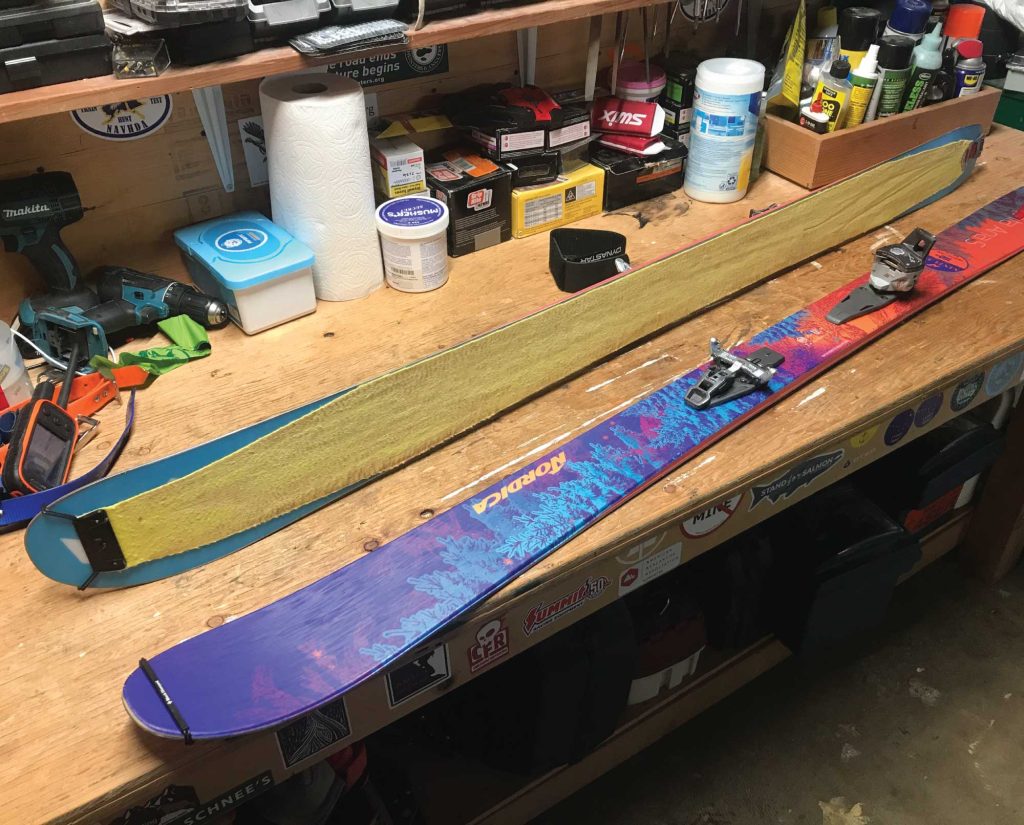
Regarding camber, I made a hunting setup with skis I picked up used from an Alaskan heli ski company. They are marketed as extreme steep and deep skis for petite women or kids. They feature a reverse camber. If you look closely, you’ll notice this upside-down camber resembles tank tracks, and that’s no mistake. This ski can tackle rough terrain, clobber brush, and can turn in place.
Ski Boots and Bindings for Upland Hunting
Bindings and boots are important, too. The ideal boot and binding setup for backcountry hunting is a “tech toe” or “pin tech” binding paired to a lightweight ski mountaineering boot. These composite and plastic boots look like resort downhill boots, but the ankle is free to move fore and aft, allowing you to easily glide deep into the wilderness. Additionally, a boot that connects to a completely free toe is critical. This free-pivot “tech toe” binding is what gives a hunter a long smooth stride to float over the snow.
Scott still uses the universal strap binding from his Glidelite skin-skis. This allows him to use the insulated winter hiking boots he already owns instead of buying expensive alpine touring boots. He loses some striding ability and side hilling stability with this method, but he can still keep up with his GSP.
Other examples of bindings that could work for hunting but are less effective than tech toes include NNN-BC, 75mm 3-pin telemark, cable telemark, and freeride alpine touring. If this is what you have already and you want to try hunting with them, then go for it. But, consider upgrading in the future.
The Perfect Backcountry Ski Upland Hunt Setup
To sum up, after three years of trial and error, I think the perfect recipe for a hunting ski setup is:
- Ski length that reaches hunter’s sternum
- Ski width is wider than your ski boot
- Construction is stiff like a resort downhill ski
- Full length metal edges
- Full-length, full-width climbing skins
- Mounted with Dynafit-style free pivot bindings
Hunting skis following these guidelines occupy a special spot in my varied quiver of ski gear. Through our long eight month bird season in Alaska, my wife, hunting buddies, and I cover a lot of miles on our dialed custom ski gear.



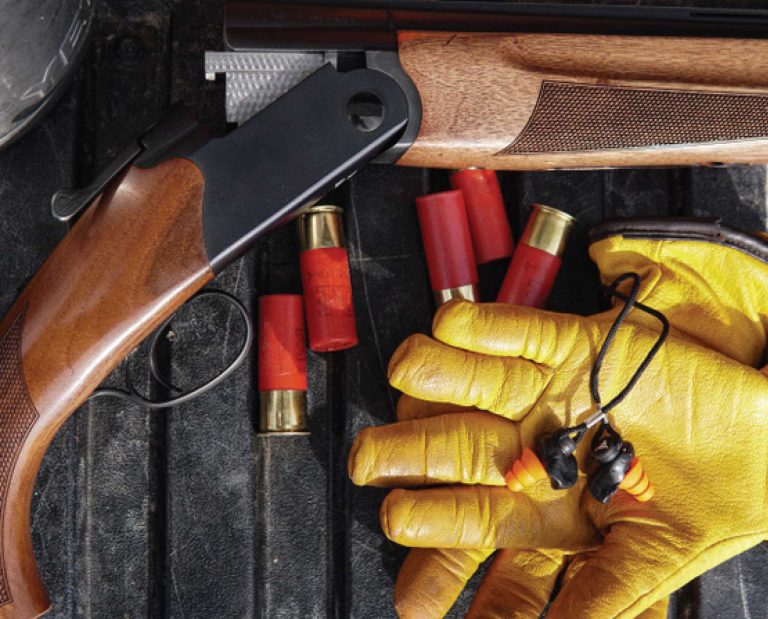
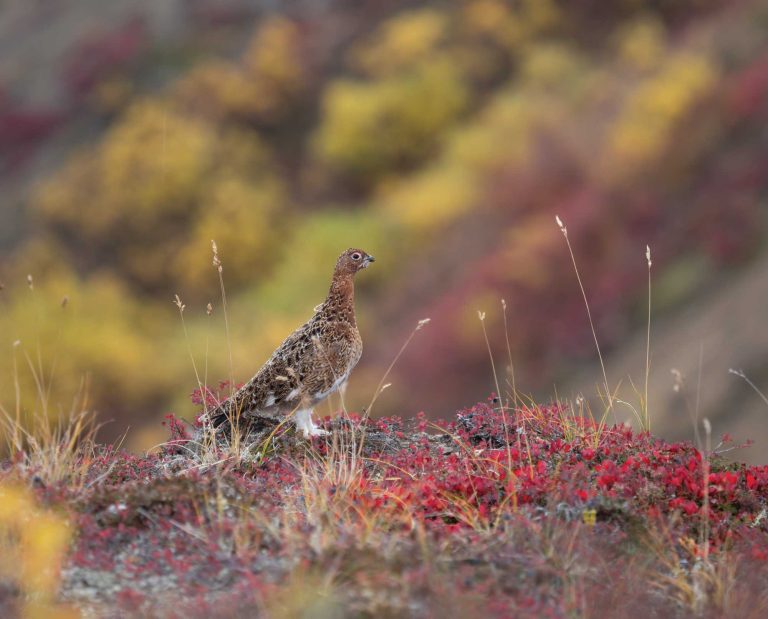

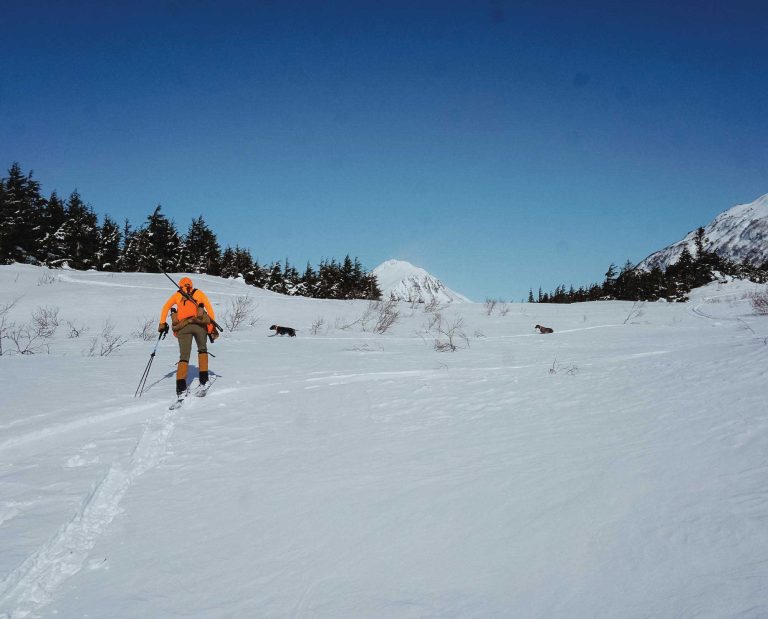

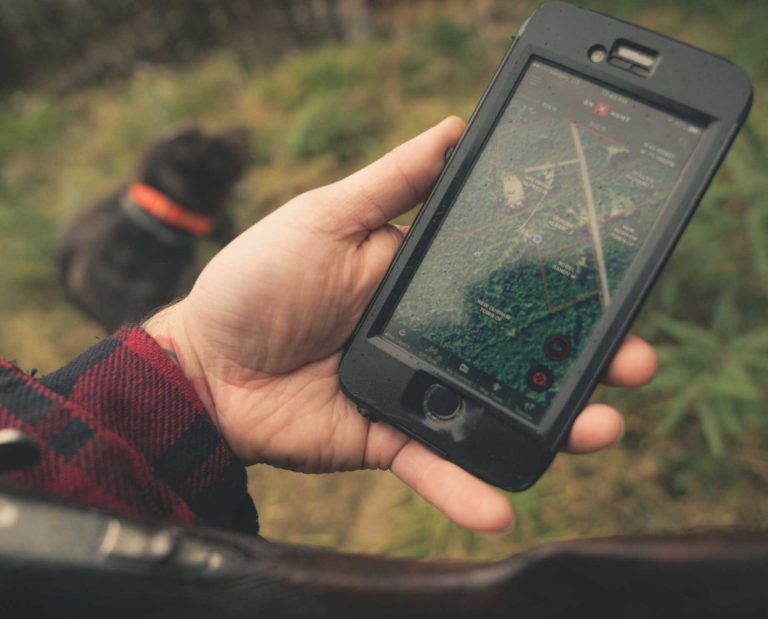
There’s a single glaring omission in the article. Avalanche safety gear.
Also, there’s a good bit of controversy in the BC Ski Community on taking dogs into the back country because of the additional avalanche risk that opens up.
Would be really good to see that addressed before proposing hunting via BC ski’s.
Great article! I m only have about 3 weeks of snowy hunting conditions in December before grouse closes, but it’s also my favourite 3 weeks with all the swamps frozen up. Snowshoes often turn to giant ice blocks in those last 3 weeks, I will use your recommendations when hunting for deals this spring. The other option I considered was split boards.
Altai Hok’s do have full metal edges. Plastic ski boots are not comfortable for covering distance. You idea of short, soft cambered women’s skis is a good one, but the rest I’m not sure. A scaled or partial skinned ski will move faster in flatter terrain than full skins. Full skins are heavy and slow. You can always add full skins to any ski, only when necessary. I would also greatly prefer a stout leather 75mm 3 pin boot. The Voile Mountaineer 3 pin binding is all that would be needed. You could go with the option of the Voile 3 Pin Cable binding and use the cables when you feel it is necessary. You can also use this setup with plastic tele boots if you want. The 75mm binding system is by far the most versatile allowing you to use a wide range of boots. AT setups require expensive plastic boots with no natural forefoot flex. No thanks.